Hello, everybody! We will continue with our World of F-mount Nikkors series! This seems to be a very popular series judging from the response I got. People like gear porn and it’s totally understandable. Part 1 talked about the normal lenses and an introduction to our new series, this part will continue where we left and we’re going to look into more types of lenses. This is a long read so I hope that you guys enjoy this (and the iPhone pictures).
Wide Primes:
Nikon is a very important part of the photography industry and many lens types that we know of today started with Nikon such as the various 70-200mm lens types and some of the wide prime lens types that we know of today. Somebody told me that Pentax and the others would open a Nikon catalog in the ’60s when thinking about which lens to make next. I shall not name the source because he is a famous photographer here in Japan but this was how things were and that is one of the reason how Nikon pioneered many of our lens types today. In fact, the word “fisheye lens” is of Japanese origin and there was only Nikon who excelled in this field until the other caught-up. The normal-macro lens family was also pioneered by Nikon, nobody thought of making a multi-use lens for macro and normal lens photography back then until the advent of the 55/3.5 family of Micro-Nikkors for the F-mount. In the wide lenses field, Nikon was making wider and wider lenses for the 35mm (SLR) format and we are going to talk about some of them here.
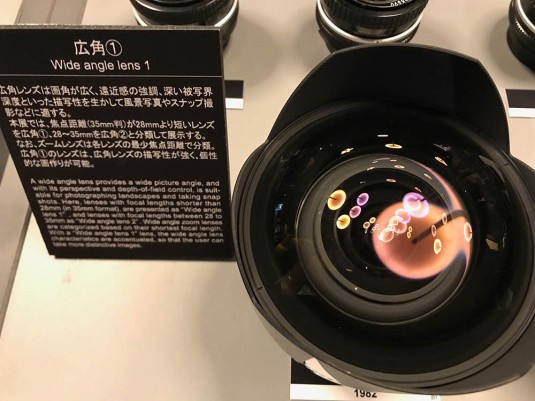 This is what the card says about wide angle lenses. These are mostly used for landscape photography but there are also other fields where these lenses excel. Nikon pioneered a lot of technologies as far as wide lenses for the 35mm format is concerned such as its CRC and the first tilt-shift lens for 35mm photography (SLR).
This is what the card says about wide angle lenses. These are mostly used for landscape photography but there are also other fields where these lenses excel. Nikon pioneered a lot of technologies as far as wide lenses for the 35mm format is concerned such as its CRC and the first tilt-shift lens for 35mm photography (SLR).
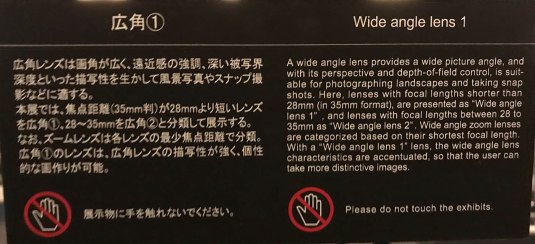 Here is a simple description of what a wide lens is all about. Nikon made plenty of wide lenses and some of the best wide lenses available were Nikkors. They were so good that photographers shooting the other brand would adapt them to their bodies!
Here is a simple description of what a wide lens is all about. Nikon made plenty of wide lenses and some of the best wide lenses available were Nikkors. They were so good that photographers shooting the other brand would adapt them to their bodies!
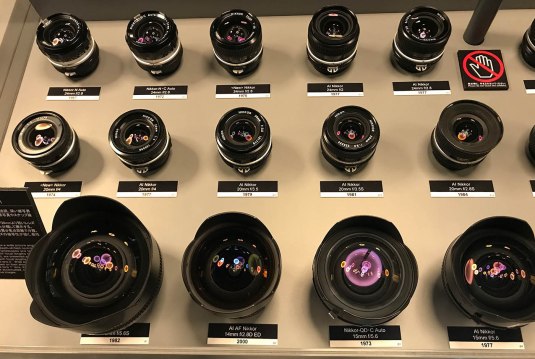 The Nikkor-N 24mm f/2.8 Auto at the top row is a very good 24mm lens. It is also the first Nikkor with CRC implemented which makes it sharp at all distances. A significant lens in terms of engineering and design. The Nikkor 20mm f/3.5 Ai-S at the next row is very good for landscapes because of its deep DOF and sharpness. This is my favorite wide lens due to its size. I used to hike a lot and the weight and size of this thing is just perfect.
The Nikkor-N 24mm f/2.8 Auto at the top row is a very good 24mm lens. It is also the first Nikkor with CRC implemented which makes it sharp at all distances. A significant lens in terms of engineering and design. The Nikkor 20mm f/3.5 Ai-S at the next row is very good for landscapes because of its deep DOF and sharpness. This is my favorite wide lens due to its size. I used to hike a lot and the weight and size of this thing is just perfect.
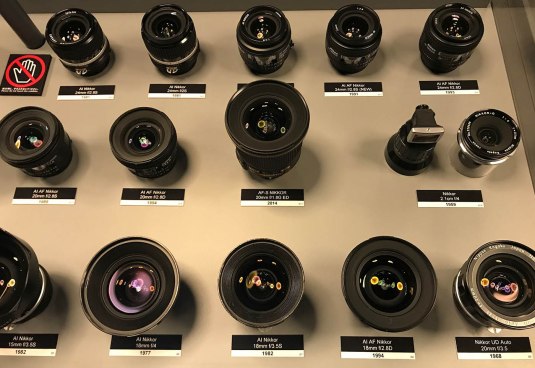 Nikon made some of the best wide lenses there is, you can even say that they are a leader in this field. Nikon has pioneered lots of new things for wide lenses like CRC.
Nikon made some of the best wide lenses there is, you can even say that they are a leader in this field. Nikon has pioneered lots of new things for wide lenses like CRC.
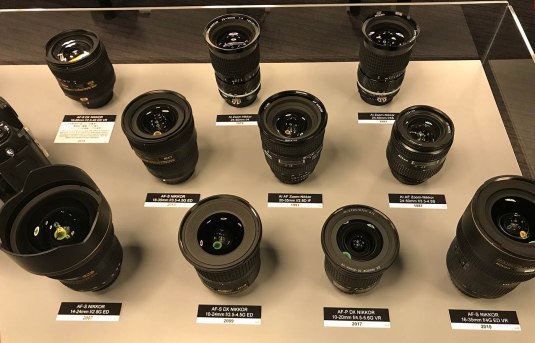 Wide zooms are very handy because you don’t have to change lenses all the time. Nikon’s 14-24mm lens is so good that it’s considered to be the best for a long time. Nobody made a lens this good until recently but there were compromises made like the fastest speed, etc.
Wide zooms are very handy because you don’t have to change lenses all the time. Nikon’s 14-24mm lens is so good that it’s considered to be the best for a long time. Nobody made a lens this good until recently but there were compromises made like the fastest speed, etc.
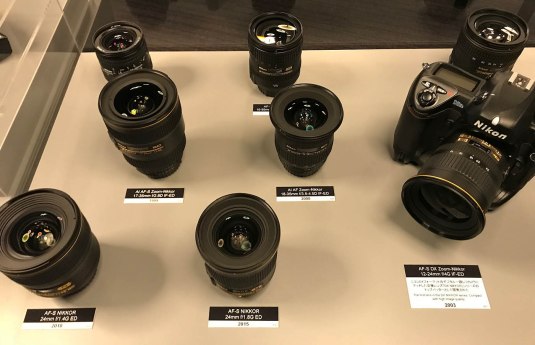 Here are some of Nikon’s great wide zooms. As somebody who shot plenty of landscape photography, I enjoyed using ultra-wide zooms. They are very handy because changing a lens while at the beach is never fun and can potentially be dangerous!
Here are some of Nikon’s great wide zooms. As somebody who shot plenty of landscape photography, I enjoyed using ultra-wide zooms. They are very handy because changing a lens while at the beach is never fun and can potentially be dangerous!
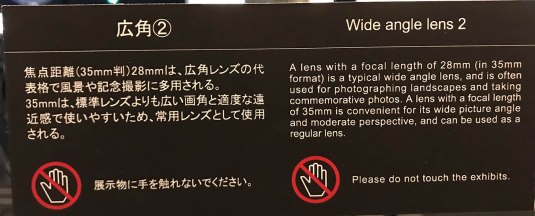 Back in the day, 35mm is considered a wide lens. Now it’s mostly used like a normal lens. I was told not to use a lens that’s wider than 35mm to photograph for newspapers since a lens that’s wider than that will “distort” the perspective of your frame or subjects which can make a story far more dramatic that it is. I don’t know, it seems that my former boss is the conservative type and not interested in sensationalism or “yellow journalism”.
Back in the day, 35mm is considered a wide lens. Now it’s mostly used like a normal lens. I was told not to use a lens that’s wider than 35mm to photograph for newspapers since a lens that’s wider than that will “distort” the perspective of your frame or subjects which can make a story far more dramatic that it is. I don’t know, it seems that my former boss is the conservative type and not interested in sensationalism or “yellow journalism”.
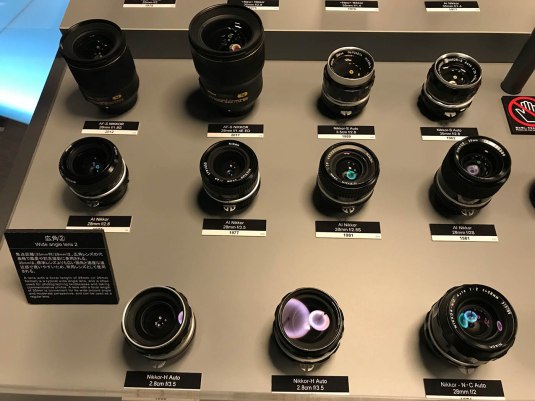 That Nikkor 28mm f/3.5 Ai-S at the center is an amazing lens, it is sharp and contrasty at every aperture. I used it on Provia and my slides looks great! All of Nikon’s 28/3.5 lenses are good and are reasonably flare-resistant. These were very popular and are produced in great numbers. They are inexpensive and you can find one easily online for sale.
That Nikkor 28mm f/3.5 Ai-S at the center is an amazing lens, it is sharp and contrasty at every aperture. I used it on Provia and my slides looks great! All of Nikon’s 28/3.5 lenses are good and are reasonably flare-resistant. These were very popular and are produced in great numbers. They are inexpensive and you can find one easily online for sale.
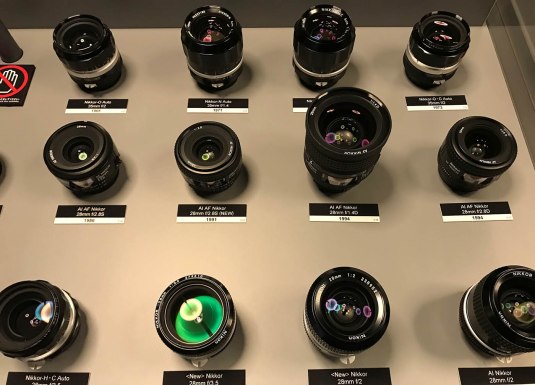 The Nikkor-O 35mm f/2 Auto at the top corner is an awesome lens. The optical formula is so good that it didn’t change much for a long time and it’s one of my favorites. All Nikkors from the 28/2.8 lens family are great performers and they’re great travel lenses.
The Nikkor-O 35mm f/2 Auto at the top corner is an awesome lens. The optical formula is so good that it didn’t change much for a long time and it’s one of my favorites. All Nikkors from the 28/2.8 lens family are great performers and they’re great travel lenses.
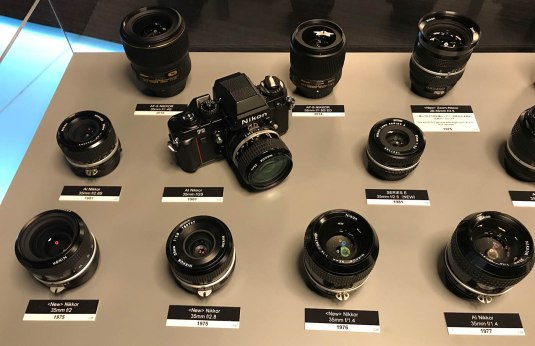 Nikon’s Nikkor 35mm f/2.8 Ai and the rest of the 35/2.8 series of lenses are great. They’re sharp and focuses really close, that’s very important for a wide lens. They are very good street photography lenses and f/2.8 is fast enough for lowlight photography.
Nikon’s Nikkor 35mm f/2.8 Ai and the rest of the 35/2.8 series of lenses are great. They’re sharp and focuses really close, that’s very important for a wide lens. They are very good street photography lenses and f/2.8 is fast enough for lowlight photography.
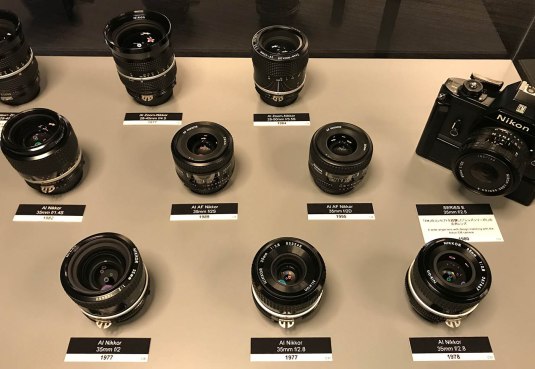 Here’s the rest of the collection. The Nikon EM was called the “Little Nikon” when it was launched many years ago. It was made to appeal to students, amateurs and ladies. It was intentionally made lite, cheap, small and easy to use. At that time, Nikon had a reputation of being tough and reliable cameras but heavy and lacked automated features that were common in the competitions’ cameras which were aimed more for amateurs. This was a big problem because pros don’t constitute the majority of Nikon’s market and this is what Nikon made to answer that. They are a joy to use and are tough little cameras.
Here’s the rest of the collection. The Nikon EM was called the “Little Nikon” when it was launched many years ago. It was made to appeal to students, amateurs and ladies. It was intentionally made lite, cheap, small and easy to use. At that time, Nikon had a reputation of being tough and reliable cameras but heavy and lacked automated features that were common in the competitions’ cameras which were aimed more for amateurs. This was a big problem because pros don’t constitute the majority of Nikon’s market and this is what Nikon made to answer that. They are a joy to use and are tough little cameras.
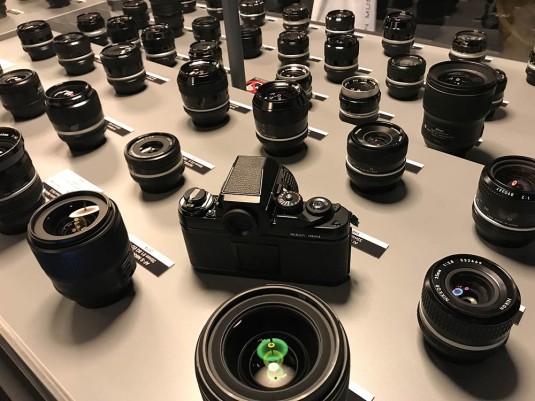 Here’s another view from the other side of the table. I really love the Nikon F3 and I love mine very much. I think it’s the most beautiful manual camera that was ever made. I like the feel of it in my hands and the features are just right. The feel of quality is everywhere and it’s a camera that was built to last 50 years of use! Nikon stated that they wanted the Nikon F3 to be serviceable for at least a couple of decades but they have dropped support for the camera and parts aren’t available anymore. The production run of the Nikon F3 is very long and if I’m not wrong the last one rolled out around 2001! Just think about it, It was being made for around 2 decades since 1980! NASA loved theirs, be sure to check my article on the NASA cameras to read more about the Nikon F3s that went to space!
Here’s another view from the other side of the table. I really love the Nikon F3 and I love mine very much. I think it’s the most beautiful manual camera that was ever made. I like the feel of it in my hands and the features are just right. The feel of quality is everywhere and it’s a camera that was built to last 50 years of use! Nikon stated that they wanted the Nikon F3 to be serviceable for at least a couple of decades but they have dropped support for the camera and parts aren’t available anymore. The production run of the Nikon F3 is very long and if I’m not wrong the last one rolled out around 2001! Just think about it, It was being made for around 2 decades since 1980! NASA loved theirs, be sure to check my article on the NASA cameras to read more about the Nikon F3s that went to space!
Telephoto:
The telephoto field is where Nikon really shined. Nikon made plenty of great long lenses since the Nikon rangefinder days. They made plenty of important breakthroughs in the ’60s as far 35mm photography is concerned and they formed the basis of much of what we enjoy today in terms of lens category and concepts. This is natural because nobody’s making these but Nikon and a few other brands, Canon came into the SLR game very late.
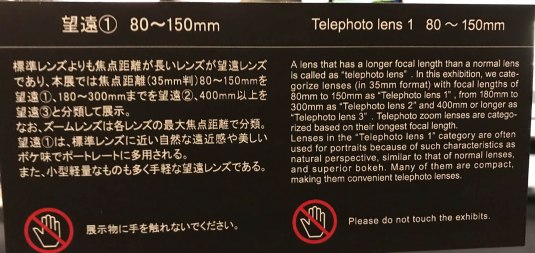 This is what the exhibit says about telephoto lenses. I was wondering why sports or other forms of photography weren’t even mentioned here in this card when it comes to the use of telephoto lenses. Maybe it’s because the 1st set belongs to the 80-150mm group.
This is what the exhibit says about telephoto lenses. I was wondering why sports or other forms of photography weren’t even mentioned here in this card when it comes to the use of telephoto lenses. Maybe it’s because the 1st set belongs to the 80-150mm group.
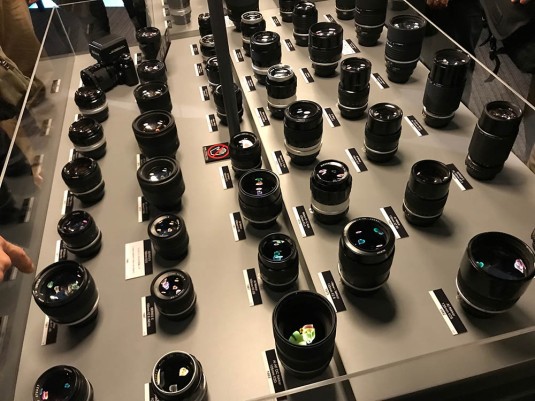 Just look at all of the Nikkors here! If my bladder was weak I’d probably wet my pants!
Just look at all of the Nikkors here! If my bladder was weak I’d probably wet my pants!
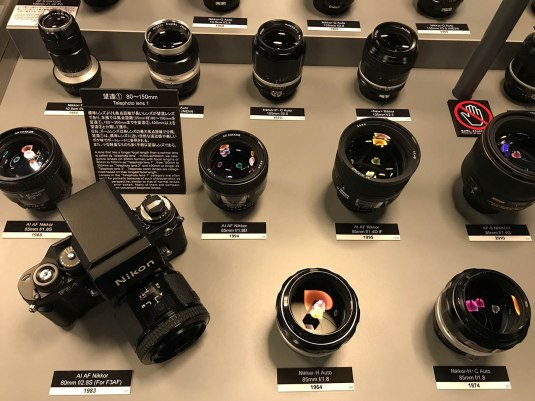 The top row has the 105mm Nikkors. The Nikkor-P 10.5cm f/2.5 Auto is a very good lens. It is a descendant of the Nikkor-P.C 10.5cm f/2.5 RF and while the optical design was altered to stay clear of the Nikon F’s mirror, the optical design hardly changed. This is probably the last telephoto Nikkor with a Sonnar design because of that connection. Next in line is the Nikkor-P.C 105mm f/2.5 Auto lens. This lens was upgraded to a Gauss design that is to last until the last version of this lens family. The New-Nikkor 105mm f/2.5 is basically the same and can be considered to be just a cosmetic upgrade. It has a more modern look to its design such as the use of a rubber grip and knurled details. It’s fun to collect Nikkors because of these variations. People can spend plenty of time just researching this!
The top row has the 105mm Nikkors. The Nikkor-P 10.5cm f/2.5 Auto is a very good lens. It is a descendant of the Nikkor-P.C 10.5cm f/2.5 RF and while the optical design was altered to stay clear of the Nikon F’s mirror, the optical design hardly changed. This is probably the last telephoto Nikkor with a Sonnar design because of that connection. Next in line is the Nikkor-P.C 105mm f/2.5 Auto lens. This lens was upgraded to a Gauss design that is to last until the last version of this lens family. The New-Nikkor 105mm f/2.5 is basically the same and can be considered to be just a cosmetic upgrade. It has a more modern look to its design such as the use of a rubber grip and knurled details. It’s fun to collect Nikkors because of these variations. People can spend plenty of time just researching this!
The Nikon F3AF is the 1st professional AF camera from Nikon that went into production. It was slow but adequate. I would like to own one one of these days and open the lenses for you to see and dissect the camera so we can study what’s inside.
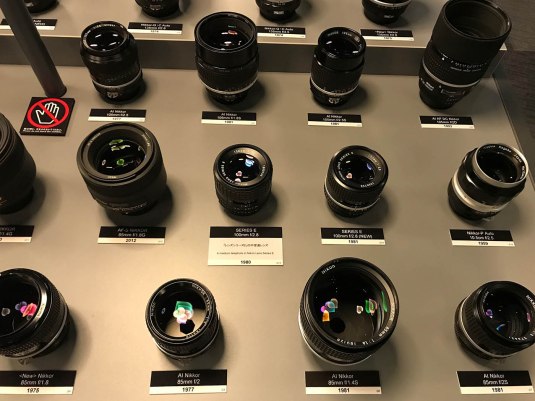 The Nikon 100mm f/2.8 Series-E lens at the center is made by Nikon but not quite a Nikkor because it was made with lower specs and materials so the Series-E lenses are not worthy of the Nikkor trade name. They were made to be cheap in order to compete with cheaper offerings from the competition, just think of these as the kit-lenses of their time. Despite being made to lesser standards, some of the Series-E lenses were pretty good. The lens at the bottom corner is the Nikkor 85mm f/2 Ai-S lens. This is a very good lens and I love it a lot because it’s sharp and the rendering is very beautiful even wide-open. It’s a good deal if you find one for sale and the optics are clean.
The Nikon 100mm f/2.8 Series-E lens at the center is made by Nikon but not quite a Nikkor because it was made with lower specs and materials so the Series-E lenses are not worthy of the Nikkor trade name. They were made to be cheap in order to compete with cheaper offerings from the competition, just think of these as the kit-lenses of their time. Despite being made to lesser standards, some of the Series-E lenses were pretty good. The lens at the bottom corner is the Nikkor 85mm f/2 Ai-S lens. This is a very good lens and I love it a lot because it’s sharp and the rendering is very beautiful even wide-open. It’s a good deal if you find one for sale and the optics are clean.
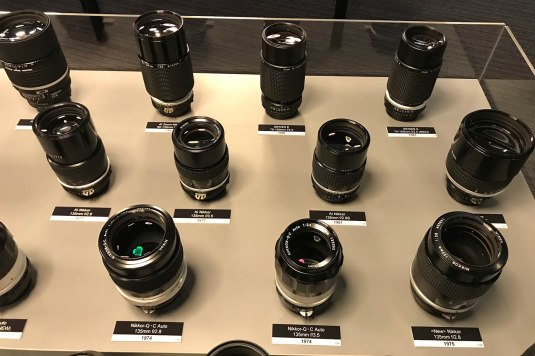 We have the 135/3.5 series of lenses here. This family of lenses was very popular since its debut in the Nikon rangefinder days. They were popular because they were inexpensive and their performance can be generally be considered to be pretty good. The first of this lens for the F-mount is the Nikkor-Q 13.5cm f/3.5 Auto. This lens has a lot of variations so collecting this lens can be fun. I love mine and they’re very good portrait lenses. Beside it is the Nikkor-Q 135mm f/2.8 Auto lens. This is an even better lens and is very good at f/2.8. Its rendering is dreamy and when used properly can add the “x-factor” to your images. It is built very tough and will survive plenty of abuse. One thing that is common in these 2 lens families is the Nikkor-Q designation. Q being the initial for quad, the latin numeral for 4. This is just saying that the lens only has 4 lens elements and in optics, less is more! This is the reason why these lenses render very beautifully and the results look natural.
We have the 135/3.5 series of lenses here. This family of lenses was very popular since its debut in the Nikon rangefinder days. They were popular because they were inexpensive and their performance can be generally be considered to be pretty good. The first of this lens for the F-mount is the Nikkor-Q 13.5cm f/3.5 Auto. This lens has a lot of variations so collecting this lens can be fun. I love mine and they’re very good portrait lenses. Beside it is the Nikkor-Q 135mm f/2.8 Auto lens. This is an even better lens and is very good at f/2.8. Its rendering is dreamy and when used properly can add the “x-factor” to your images. It is built very tough and will survive plenty of abuse. One thing that is common in these 2 lens families is the Nikkor-Q designation. Q being the initial for quad, the latin numeral for 4. This is just saying that the lens only has 4 lens elements and in optics, less is more! This is the reason why these lenses render very beautifully and the results look natural.
The lens to the left is the Nikkor 135mm f/2.8 Ai. This is a total upgrade because its optics are totally new. It’s considered to be a better lens in every respect compared to the older lens and is a very good lens for many tasks. I suggest that you buy one when you see one for sale. It’s going to be one of your favorite lenses because of its performance. The lens at the top is the Nikon 75-150mm f/3.5 Series-E zoom. It’s a very good lens for travel and a host of other fields where weight is important. The late Galen Rowell used this lens for a few of his masterpieces. He pioneered the mountaineering photographer genre and this lens perfect for that. It’s lite but the image quality from this lens is amazing.
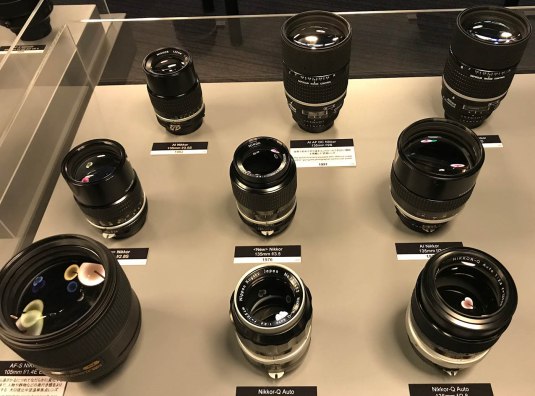 Here’s another view from the set. I really love the lenses here because they are practical and their image quality is amazing. You really can’t go wrong with any of the lenses here.
Here’s another view from the set. I really love the lenses here because they are practical and their image quality is amazing. You really can’t go wrong with any of the lenses here.
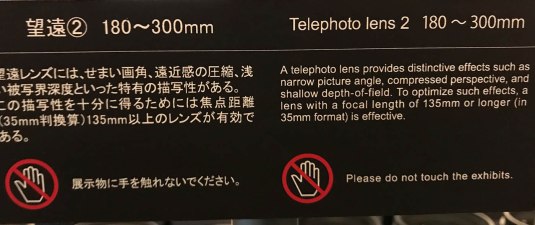 Here’s the next set! This time, we are going to the 180-300mm range! Things are getting a little more interesting here as we get more exotic lenses from this point!
Here’s the next set! This time, we are going to the 180-300mm range! Things are getting a little more interesting here as we get more exotic lenses from this point!
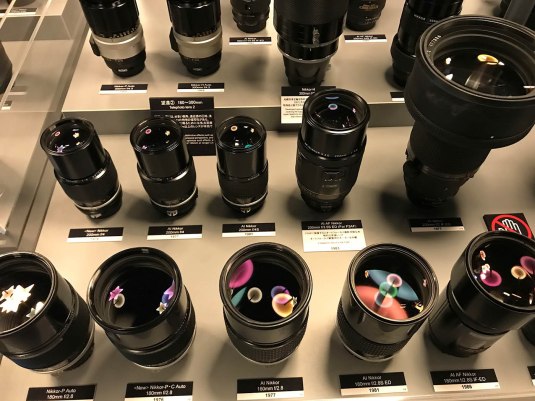 The lens at the bottom is the Nikkor-P 180mm f/2.8 Auto lens. It’s the first lens of this lens family and is a very good performer. All of the lenses in this lens family is great from this to the last version which has autofocus. The lens at the middle is the Nikkor 200mm f/4 Ai lens. This is a very important upgrade from the Nikkor-Q 200mm f/4 Auto because it was designed to be a lot shorter and lighter than its predecessor. The optics were changed so this is a totally new lens. The first lens in this series is the Nikkor-Q 20cm f/4 Auto and it’s a very significant lens because it’s the original long prime for the F-mount. This lens was key to demonstrating the superiority of the SLR system vs the rangefinders and others. It showed how you can accurately compose and focus your frame with a long lens without the use of weird add-ons and contraptions just to make it happen. I’m stating this as fact so I’m sorry if I hurt any rangefinder lovers here, it is what it is.
The lens at the bottom is the Nikkor-P 180mm f/2.8 Auto lens. It’s the first lens of this lens family and is a very good performer. All of the lenses in this lens family is great from this to the last version which has autofocus. The lens at the middle is the Nikkor 200mm f/4 Ai lens. This is a very important upgrade from the Nikkor-Q 200mm f/4 Auto because it was designed to be a lot shorter and lighter than its predecessor. The optics were changed so this is a totally new lens. The first lens in this series is the Nikkor-Q 20cm f/4 Auto and it’s a very significant lens because it’s the original long prime for the F-mount. This lens was key to demonstrating the superiority of the SLR system vs the rangefinders and others. It showed how you can accurately compose and focus your frame with a long lens without the use of weird add-ons and contraptions just to make it happen. I’m stating this as fact so I’m sorry if I hurt any rangefinder lovers here, it is what it is.
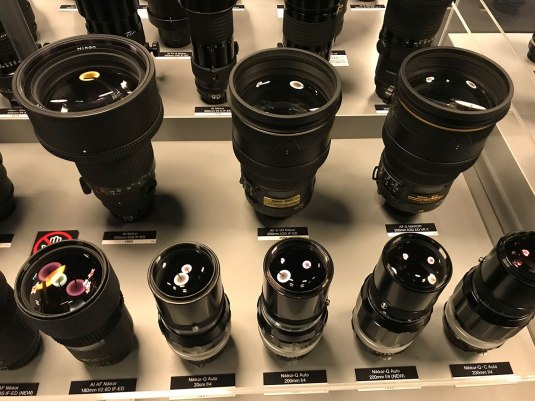 Here’s a picture of the other end of the table. I don’t know why they placed the rest of the 200/4 lens family here. The maximum opening of f/4 may seem slow to you but that’s fast enough for many things and most importantly, the lens is more compact than the faster ones. Just look at the big lenses above these to know what I mean. You only get about 2 f-stops faster but the resulting lens is more than 2x bigger. The f/4 speed is a compromise.
Here’s a picture of the other end of the table. I don’t know why they placed the rest of the 200/4 lens family here. The maximum opening of f/4 may seem slow to you but that’s fast enough for many things and most importantly, the lens is more compact than the faster ones. Just look at the big lenses above these to know what I mean. You only get about 2 f-stops faster but the resulting lens is more than 2x bigger. The f/4 speed is a compromise.
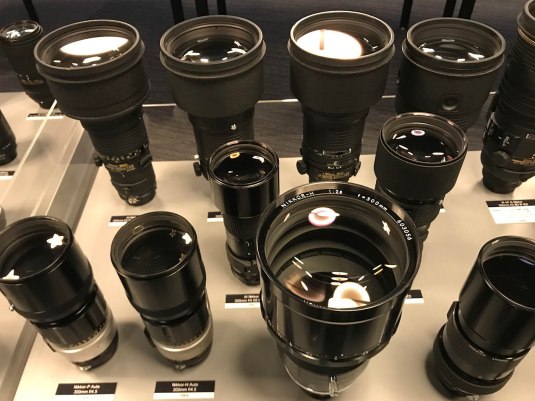 We are now getting into the land of the giants! I hate working on these lenses. They are a pain to work with because they are big and heavy. They also need more effort since the screws used are bigger and the barrel threads are longer.
We are now getting into the land of the giants! I hate working on these lenses. They are a pain to work with because they are big and heavy. They also need more effort since the screws used are bigger and the barrel threads are longer.
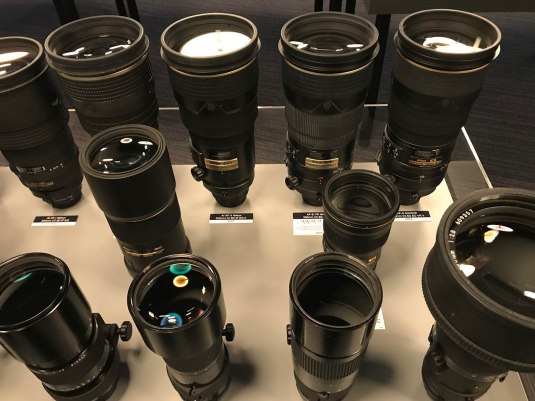 Here are more examples of Nikon’s exotic telephoto lenses. I want to buy the big lenses in this display but I just don’t have the place to store them!
Here are more examples of Nikon’s exotic telephoto lenses. I want to buy the big lenses in this display but I just don’t have the place to store them!
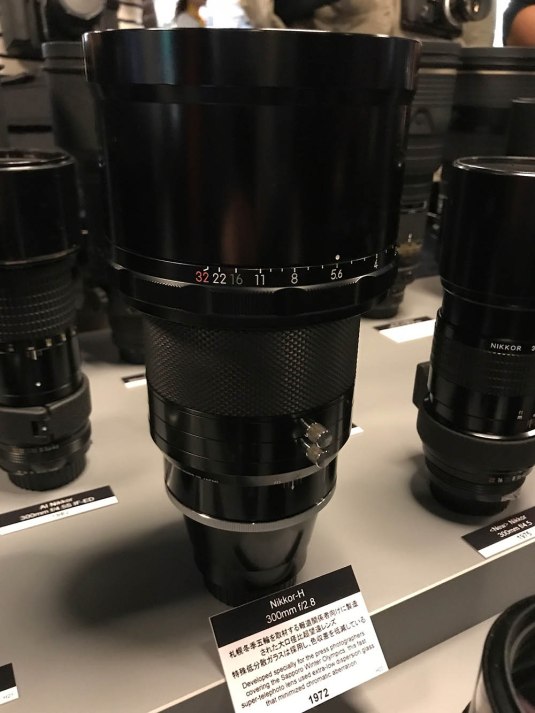 Wow, just look at that! Can you see yourself hand-holding this monster lens!?
Wow, just look at that! Can you see yourself hand-holding this monster lens!?
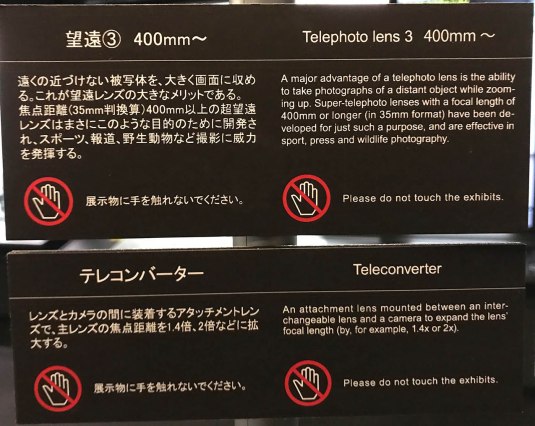 Nikon made some of the world’s longest lenses for SLR cameras and we will see some of those here. This section houses lenses that are longer than 400mm so this is the rich boys’ club! These lenses are usually out-of-reach for most photographers unless they have very special needs like shooting news, sports or wildlife. It’s also interesting that Nikon added teleconverters into this section. It makes sense anyway because teleconverters are often used with this class of lenses. Adding a teleconverter to add more reach is much cheaper than buying a proper lens with the longer focal length that you wanted. You can also use the lens as-is with out the teleconverter or you can use your teleconverter with another lens that you own. It’s accepted that teleconverters take away some image quality in the form of sharpness from your pictures but there are some teleconverters that are so good that you hardly notice anything. Some teleconverters also work better with some combos so figuring out which one is works best with what is part of the fun in using these.
Nikon made some of the world’s longest lenses for SLR cameras and we will see some of those here. This section houses lenses that are longer than 400mm so this is the rich boys’ club! These lenses are usually out-of-reach for most photographers unless they have very special needs like shooting news, sports or wildlife. It’s also interesting that Nikon added teleconverters into this section. It makes sense anyway because teleconverters are often used with this class of lenses. Adding a teleconverter to add more reach is much cheaper than buying a proper lens with the longer focal length that you wanted. You can also use the lens as-is with out the teleconverter or you can use your teleconverter with another lens that you own. It’s accepted that teleconverters take away some image quality in the form of sharpness from your pictures but there are some teleconverters that are so good that you hardly notice anything. Some teleconverters also work better with some combos so figuring out which one is works best with what is part of the fun in using these.
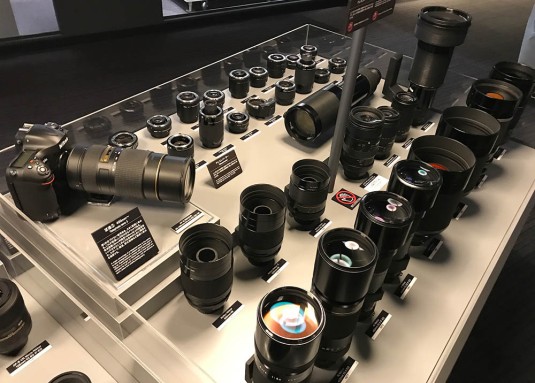 Here is the main table for this part of the exhibit. Almost all of the lenses here are so big they need to be mounted on a sturdy base. That AF-S NIKKOR 80-400mm f/4.5-5.6G ED VR is a misfit and I don’t know why that thing’s included in the first place.
Here is the main table for this part of the exhibit. Almost all of the lenses here are so big they need to be mounted on a sturdy base. That AF-S NIKKOR 80-400mm f/4.5-5.6G ED VR is a misfit and I don’t know why that thing’s included in the first place.
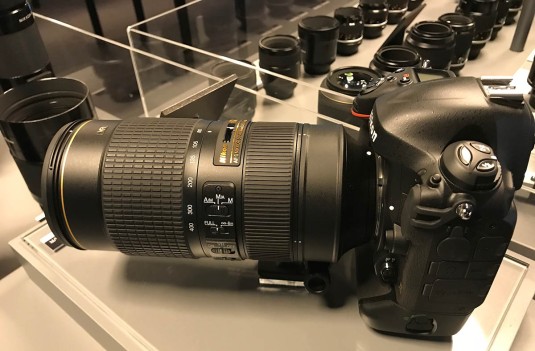 Here’s a closer look at the AF-S NIKKOR 80-400mm f/4.5-5.6G ED VR. It’s a very goos lens. I can say that this lens is generations ahead of its predecessor. It’s so sharp wide-open and its AF is fast and snappy. This lens is the standard in which other lenses in its class are to be judged with. It’s not cheap but it certainly isn’t so expensive that you can’t afford one.
Here’s a closer look at the AF-S NIKKOR 80-400mm f/4.5-5.6G ED VR. It’s a very goos lens. I can say that this lens is generations ahead of its predecessor. It’s so sharp wide-open and its AF is fast and snappy. This lens is the standard in which other lenses in its class are to be judged with. It’s not cheap but it certainly isn’t so expensive that you can’t afford one.
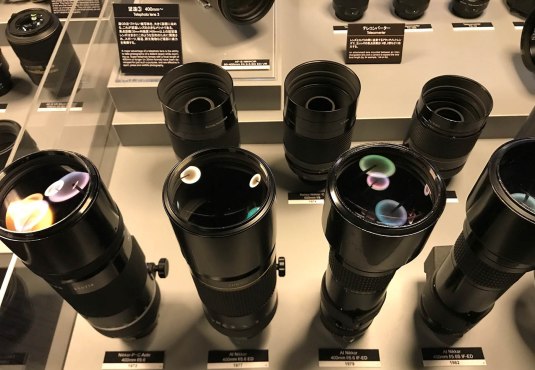 Here are the “shortest” lenses in this group. The 400mm focal length isn’t long enough for many wildlife photographers so many people use teleconverters with these. They’re good for sports because they aren’t so big that you should only use them with a tripod and the reasonably fast f/5.6 opening is a compromise just so that you can get something smaller yet fast enough to allow you to use faster shutter speeds like 1/500s (at least) for sports.
Here are the “shortest” lenses in this group. The 400mm focal length isn’t long enough for many wildlife photographers so many people use teleconverters with these. They’re good for sports because they aren’t so big that you should only use them with a tripod and the reasonably fast f/5.6 opening is a compromise just so that you can get something smaller yet fast enough to allow you to use faster shutter speeds like 1/500s (at least) for sports.
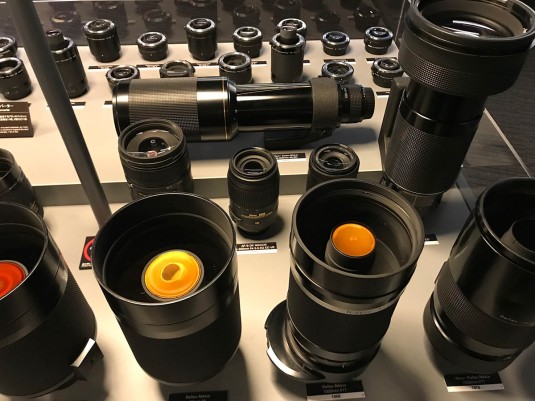 These lenses are called mirror lenses. They are a totally different type of lenses because they reflect light instead of refracting it. This design allows you to have a compact barrel with a long focal length. They used to be popular but I don’t know what happened and I don’t see these being used anymore. My friend owned one back in the day and he used it for creep shots at the beach when creep shots weren’t even a thing! The drawback of this design is that you are stuck with one focal length and aperture. You also can’t use filters at the front so filters have to be placed at the rear or within the barrel via a small port. It is also known to give you donut-shaped bokeh and that’s ugly! You’ll also lose sharpness and contrast with mirror lenses so. One thing that I hate is their relatively slow aperture and that’s why my friend only used his mirror lenses at the beach for creep shots!
These lenses are called mirror lenses. They are a totally different type of lenses because they reflect light instead of refracting it. This design allows you to have a compact barrel with a long focal length. They used to be popular but I don’t know what happened and I don’t see these being used anymore. My friend owned one back in the day and he used it for creep shots at the beach when creep shots weren’t even a thing! The drawback of this design is that you are stuck with one focal length and aperture. You also can’t use filters at the front so filters have to be placed at the rear or within the barrel via a small port. It is also known to give you donut-shaped bokeh and that’s ugly! You’ll also lose sharpness and contrast with mirror lenses so. One thing that I hate is their relatively slow aperture and that’s why my friend only used his mirror lenses at the beach for creep shots!
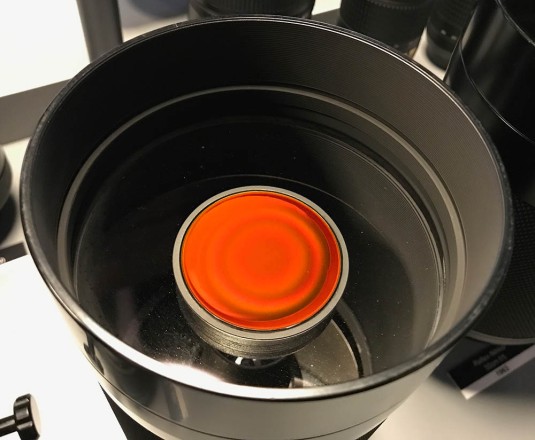 You see that thing at the center? That’s where the secondary mirror is. The design is very simple and all you need are corrective lenses and a primary and a secondary mirror. If you think that this looks and sounds familiar then that’s because many telescopes made for personal and scientific uses were made with the same principle. Just think of it like a mini telescope for astronomy that you can mount on your cameras to shoot creep shots.
You see that thing at the center? That’s where the secondary mirror is. The design is very simple and all you need are corrective lenses and a primary and a secondary mirror. If you think that this looks and sounds familiar then that’s because many telescopes made for personal and scientific uses were made with the same principle. Just think of it like a mini telescope for astronomy that you can mount on your cameras to shoot creep shots.
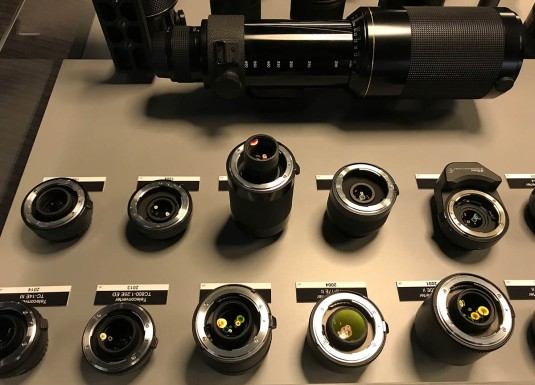 This is the teleconverter section. Nikon made plenty of these for decades. The latest ones even have fancy ED glass elements. A teleconverter basically is a magnifying lens group that helps magnify your frame. The addition of more glass in your light’s path is why the pictures from a setup with teleconverters aren’t as sharp as the one without them. Like I mentioned in the previous section, some teleconverters are so good with some lenses you cannot really see a lot of differences when you put the pictures side-by-side.
This is the teleconverter section. Nikon made plenty of these for decades. The latest ones even have fancy ED glass elements. A teleconverter basically is a magnifying lens group that helps magnify your frame. The addition of more glass in your light’s path is why the pictures from a setup with teleconverters aren’t as sharp as the one without them. Like I mentioned in the previous section, some teleconverters are so good with some lenses you cannot really see a lot of differences when you put the pictures side-by-side.
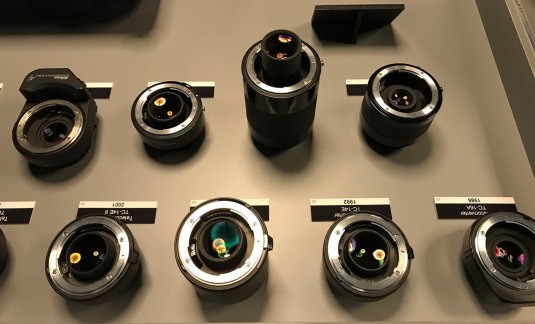 Here are more Nikon teleconverters for you to drool over with.
Here are more Nikon teleconverters for you to drool over with.
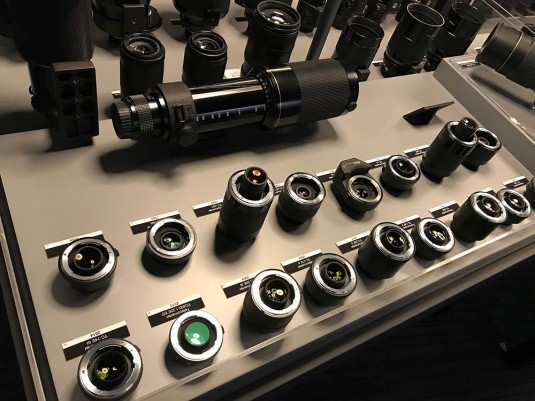 Let’s have a final look at this table. The really long lenses will be shown on the next blog post so be sure to come back to see the real giants! I will publish it in 2 week’s time.
Let’s have a final look at this table. The really long lenses will be shown on the next blog post so be sure to come back to see the real giants! I will publish it in 2 week’s time.
Special:
Here we are at the last section! Nikon consolidated all the Micro-Nikkors, PC-Nikkors and Medical-Nikkors into one group. This is probably to save floor area because separating it into their own tables will just make the museum floor hard to navigate and accidents can happen! Dangerous! This is my personal favorite because I love the Micro-Nikkor lenses.
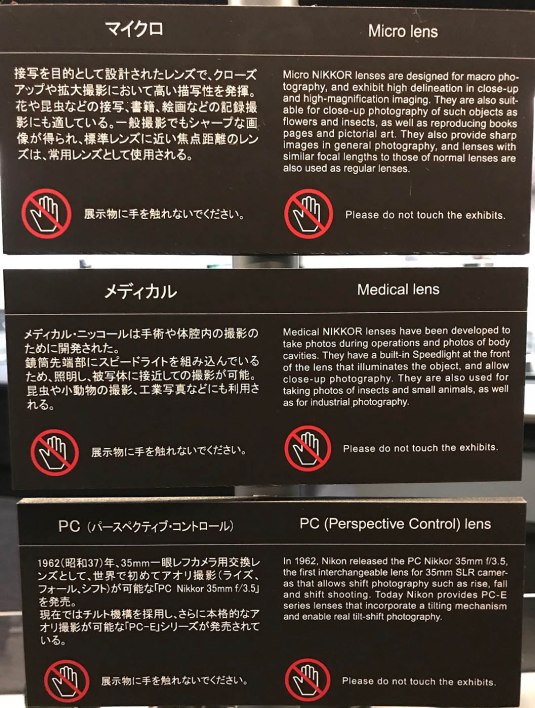 This is what the card has to say about these lenses. I generally agree with everything that was printed here. I also use my Micro-Nikkors as standard lenses because they’re sharp.
This is what the card has to say about these lenses. I generally agree with everything that was printed here. I also use my Micro-Nikkors as standard lenses because they’re sharp.
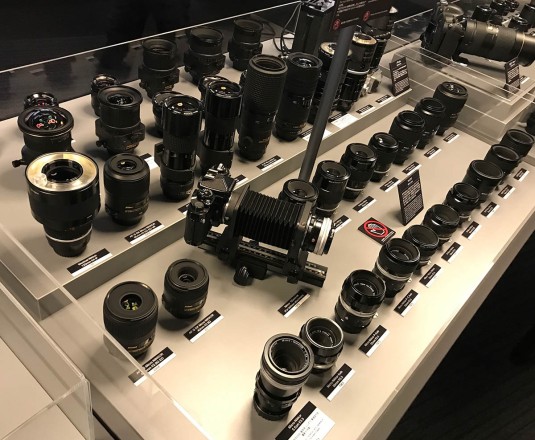 Here’s the main table. Oh, my goodness. I really love this so much because of all the nice Micro-Nikkors shown here! This is amateur porn as far as lens porn is concerned!
Here’s the main table. Oh, my goodness. I really love this so much because of all the nice Micro-Nikkors shown here! This is amateur porn as far as lens porn is concerned!
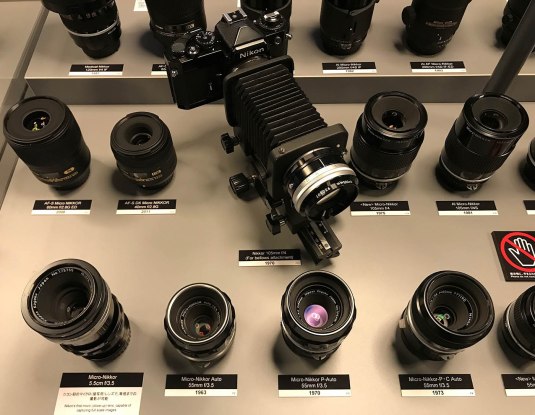 Here’s a closer look. Macro photography used to be very difficult before the SLR and you need to use special reflex housings just to see what you are photographing or measure it with a ruler and then focus your setup manually. How you get properly-focused pictures with this is anybody’s guess. It’s probably OK for flat and stationary objects but I do not see how you can effectively use this on other types of subjects. The SLR is liberated the photographer in many ways and it allowed us to take pictures with precise framing and focus. Imagine doing this with a rangefinder, let’s see where that bug will end up in your frame! The reflex mirror is like the “live view” of years past, it was a big revolution.
Here’s a closer look. Macro photography used to be very difficult before the SLR and you need to use special reflex housings just to see what you are photographing or measure it with a ruler and then focus your setup manually. How you get properly-focused pictures with this is anybody’s guess. It’s probably OK for flat and stationary objects but I do not see how you can effectively use this on other types of subjects. The SLR is liberated the photographer in many ways and it allowed us to take pictures with precise framing and focus. Imagine doing this with a rangefinder, let’s see where that bug will end up in your frame! The reflex mirror is like the “live view” of years past, it was a big revolution.
The first lens in the 105mm Micro-Nikkor family for the F-mount is the old but venerable Micro-Nikkor 105mm f/4 AI lens. This lens is a great performer and is treasured by many macro photographers. It started the whole trend of having a longer macro lens so you’ll be able to take pictures of bugs without scaring them.
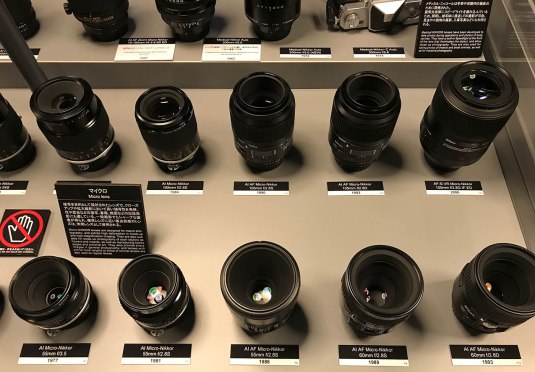 I currently have or have owned almost every lens in this picture. They are all very good and can be considered to be the top of their class. That Micro-Nikkor 105mm f/2.8 Ai-S at the top is a very good lens. It has CRC and the fast f/2.8 maximum aperture helps with the focusing of this lens. As you focus closer, your lens extends a lot and with that you lose a stop of light or more if you are using extension tubes. This can get really difficult when you are shooting without the automatic iris function such as when you’re using bellows. This lens is still being made and sold to this day! That’s more than 3 decades!
I currently have or have owned almost every lens in this picture. They are all very good and can be considered to be the top of their class. That Micro-Nikkor 105mm f/2.8 Ai-S at the top is a very good lens. It has CRC and the fast f/2.8 maximum aperture helps with the focusing of this lens. As you focus closer, your lens extends a lot and with that you lose a stop of light or more if you are using extension tubes. This can get really difficult when you are shooting without the automatic iris function such as when you’re using bellows. This lens is still being made and sold to this day! That’s more than 3 decades!
The Nikkor 105mm f/2.8G ED IF AF-S VR lens at the other end of the table is the latest one in the series. It adds a “Silent Wave Motor” or SWM to the design and is internal-focusing so your lens doesn’t extend as you focus closer. What was surprising for many when this came out was thing thing has VR! This feature alone made this the most advanced macro lens available when it came out. I remember the accolades up to this day. It’s a good lens and is also handy for portraits and general photography because of the VR.
The Micro-Nikkor 55mm f/2.8 Ai-S at the bottom is one of Nikon’s best lenses of all time. It is even being manufactured and sold as new to this day. NASA has a special version of it that went to space. They use it to take pictures of any damage to the thermal plates of the space shuttle. This is also one of John Free’s favorite lenses I can assume because he uses it with his Nikon F3 in some of his pictures and videos where he is seen in-frame. It’s not only a good macro lens but it’s also an excellent normal lens. Very good value.
To the corner is the AF Micro-Nikkor 60mm f/2.8D lens. This lens is very versatile and you can use it for general photography despite having a slowish AF. It is one of the sharpest lenses that I have used and as you guys know, I’ve used a lot of lenses through the years. This lens has been replaced in 2009 but it’s still being produced and sold new up to this day. You ask why Nikon keeps on making these macro lenses despite them being obsolete due to their replacements in the catalog. Well, the answer is because there’s still demand for these in the scientific and amateur circle. When an institution gives you a budget, you will buy a new one of course or else you will face corruption complaints from your head or the accountant because of quality or monetary issues. I’m saying this because a friend of mine is a scientist and this is how they do things and we can assume that majority of the better-funded institutions do this as well or their reputation is at stake.
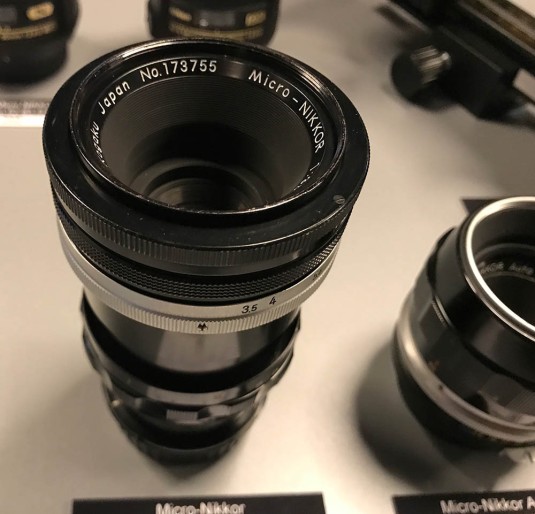 Here’s a series of pictures from my favorite lens family, the 55/3.5 line of macro lenses. It a very diverse line of lenses and it pioneered a lot of things. The first in this long line of lenses is the Micro-Nikkor 5.5cm f/3.5 preset lens. It’s called “preset” because you’ll have to close the iris manually because it doesn’t have an automatic iris. This is a rare lens and I have 3 examples of it. Some people even modify these so they can use them on cameras from other brands because nobody but Nikon made these types of lenses back in the day. This lens is awkward to use but it’s a transitional design from the one used in the days of the Nikon S rangefinder to the F-mount versions that became mainstream later. They are sharp but field curvature isn’t as flat as later lenses and this can be a problem if you are using this lens to shoot documents, slides or other flat objects. Field curvature affects the overall sharpness of your frame. If you have a flat field, your focus plane is flat and that means that the sharpness is evenly-distributed throughout a thin slice of focused area. If you have a curved field, the focused area is much smaller so your center may be sharp or focused but the sides aren’t because the focus plane is not as flat.
Here’s a series of pictures from my favorite lens family, the 55/3.5 line of macro lenses. It a very diverse line of lenses and it pioneered a lot of things. The first in this long line of lenses is the Micro-Nikkor 5.5cm f/3.5 preset lens. It’s called “preset” because you’ll have to close the iris manually because it doesn’t have an automatic iris. This is a rare lens and I have 3 examples of it. Some people even modify these so they can use them on cameras from other brands because nobody but Nikon made these types of lenses back in the day. This lens is awkward to use but it’s a transitional design from the one used in the days of the Nikon S rangefinder to the F-mount versions that became mainstream later. They are sharp but field curvature isn’t as flat as later lenses and this can be a problem if you are using this lens to shoot documents, slides or other flat objects. Field curvature affects the overall sharpness of your frame. If you have a flat field, your focus plane is flat and that means that the sharpness is evenly-distributed throughout a thin slice of focused area. If you have a curved field, the focused area is much smaller so your center may be sharp or focused but the sides aren’t because the focus plane is not as flat.
It has been cut-off in the picture but the next lens is the Micro-Nikkor-P 55mm f/3.5 Auto. It’s a very important lens because it set the standard for all of Nikon’s Micro-Nikkors for the next couple of decades to come. Its design is practical and it’s a compromise from the earlier Micro-Nikkor 5.5cm f/3.5 because in exchange for better handling it lost the ability to focus all the way to 1:1 magnification. You can get that magnification by using the tube that Nikon sold with it called the M-ring. This lens is also peculiar in that it has gimmick that allows it to open-up the iris as you focus closer. This is compensates for the lost light as the barrel gets longer and that is why this is called the “compensating version” by some people. The trick is the slot for the iris is slanted so that the iris mechanism opens up as the barrel extends when you rack focus. This is a very nice trick that would soon be used as the foundation of CRC where the idea was applied to a lens group instead of the iris.
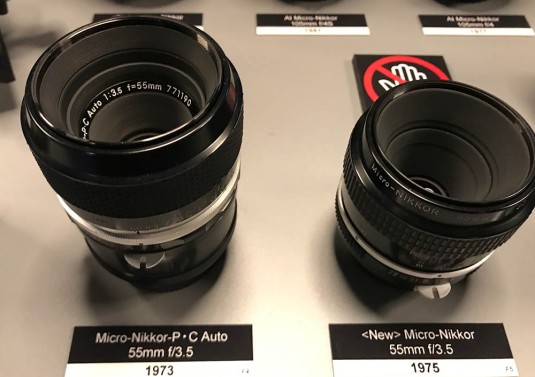 These Micro-Nikkors are just updates of the ancient Micro-Nikkor-P 55mm f/3.5 Auto lens. The optics largely remained the same despite some very minor tweaking and the barrel has been completely redesigned to fit with the times. One big thing that was changed is the “compensating” feature and it has been dropped in these lenses. It doesn’t make any sense at all because during the era when these lenses were introduced, not a lot of folks took manual flash measurements because if TTL flash metering. Just like many serious macro photographers, I set my flash to manual so the compensating feature is handy.
These Micro-Nikkors are just updates of the ancient Micro-Nikkor-P 55mm f/3.5 Auto lens. The optics largely remained the same despite some very minor tweaking and the barrel has been completely redesigned to fit with the times. One big thing that was changed is the “compensating” feature and it has been dropped in these lenses. It doesn’t make any sense at all because during the era when these lenses were introduced, not a lot of folks took manual flash measurements because if TTL flash metering. Just like many serious macro photographers, I set my flash to manual so the compensating feature is handy.
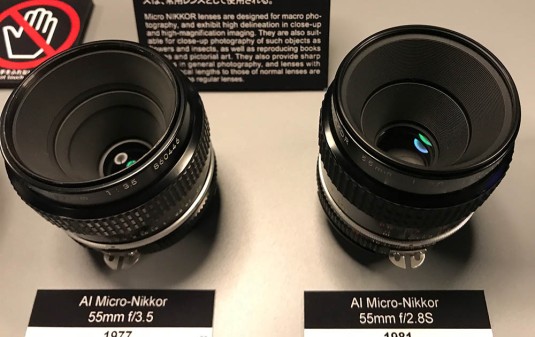 Here’s a closer look at the neighbors. Aren’t they pretty? The Micro-Nikkors are the most beautiful lenses made by Nikon (or anybody) according to yours truly. If sex can be a lens then it will be a Micro-Nikkor. There is no words to describe these little beauties.
Here’s a closer look at the neighbors. Aren’t they pretty? The Micro-Nikkors are the most beautiful lenses made by Nikon (or anybody) according to yours truly. If sex can be a lens then it will be a Micro-Nikkor. There is no words to describe these little beauties.
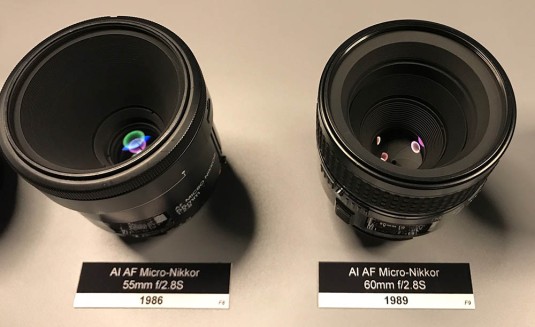 These AF Micro-Nikkors both go down to 1:1 magnification without any attachments. The trick is that they use a cam to focus in or out and that allows it to achieve a long extended “erection”. I’m sorry but I can’t think of any other words to use at this point. I’m sober but I have a cold so my faculties are at fault here. If you want to know how this is achieved, I suggest that you read my AF Micro-Nikkor 60mm f/2.8D article.
These AF Micro-Nikkors both go down to 1:1 magnification without any attachments. The trick is that they use a cam to focus in or out and that allows it to achieve a long extended “erection”. I’m sorry but I can’t think of any other words to use at this point. I’m sober but I have a cold so my faculties are at fault here. If you want to know how this is achieved, I suggest that you read my AF Micro-Nikkor 60mm f/2.8D article.
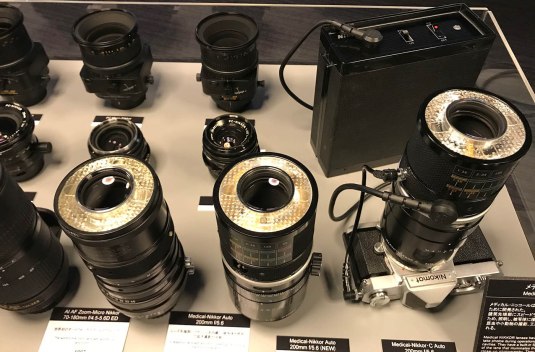 These are Medical-Nikkors. These lenses have their own ring light and power source. The design seems odd now but it was necessary some decades ago. These are used by doctors and dentists where a perfectly-illuminated subject is important. These are macro lenses with a twist and they also come with special screw-in magnifying attachments that looks like UV filters. They have fallen out of use as Nikon made better macro lenses and flashes with very accurate metering that can be attached to the front of the lens. Needless to say, these were also used by engineers, scientists and other people who need to take pictures of their subjects without any distortion and as true-to-life as possible. They’re cheap now but a complete set is going to set you back a couple of hundred US dollars.
These are Medical-Nikkors. These lenses have their own ring light and power source. The design seems odd now but it was necessary some decades ago. These are used by doctors and dentists where a perfectly-illuminated subject is important. These are macro lenses with a twist and they also come with special screw-in magnifying attachments that looks like UV filters. They have fallen out of use as Nikon made better macro lenses and flashes with very accurate metering that can be attached to the front of the lens. Needless to say, these were also used by engineers, scientists and other people who need to take pictures of their subjects without any distortion and as true-to-life as possible. They’re cheap now but a complete set is going to set you back a couple of hundred US dollars.
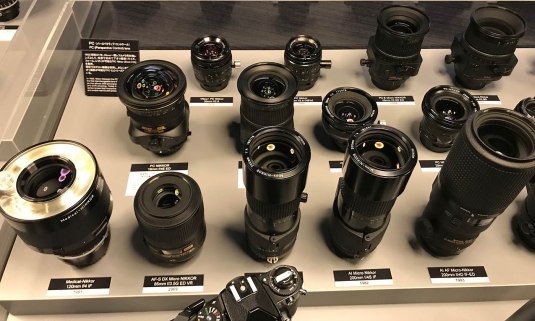 Well, I didn’t take a lot of pictures of the PC-Nikkors at the back. PC stands for perspective controls. It’s just Nikon’s fancy marketing name for a tilt-shift lens. Nikon is the first one to make them for 35mm photography with the debut of the PC-Nikkor 35mm f/3.5 lens. It’s an important lens historically because for the first time, it demonstrated that 35mm can also be used for more technical types of photography. This used to be the exclusive of the larger film formats but this lens changed it all. Now, 35mm photographers can also enjoy using this effect without the need for bellows or other awkward contraptions. These are also used to modify perspective and your focal plane that is why many landscape, food and product photographers use these lenses. Just think about how you can get everything in-focus without using one of these when you are shooting jewelry draped on a board or a field of flowers while still getting both the foreground and background sharp. This can also be used to take pictures that looks “miniaturized”. Architectural photography is also a big application for this because you can modify your vanishing lines so that buildings don’t taper at the top when you are shooting from below or from a high place. This is a very handy lens with very special applications. You’ll know if this one is for you.
Well, I didn’t take a lot of pictures of the PC-Nikkors at the back. PC stands for perspective controls. It’s just Nikon’s fancy marketing name for a tilt-shift lens. Nikon is the first one to make them for 35mm photography with the debut of the PC-Nikkor 35mm f/3.5 lens. It’s an important lens historically because for the first time, it demonstrated that 35mm can also be used for more technical types of photography. This used to be the exclusive of the larger film formats but this lens changed it all. Now, 35mm photographers can also enjoy using this effect without the need for bellows or other awkward contraptions. These are also used to modify perspective and your focal plane that is why many landscape, food and product photographers use these lenses. Just think about how you can get everything in-focus without using one of these when you are shooting jewelry draped on a board or a field of flowers while still getting both the foreground and background sharp. This can also be used to take pictures that looks “miniaturized”. Architectural photography is also a big application for this because you can modify your vanishing lines so that buildings don’t taper at the top when you are shooting from below or from a high place. This is a very handy lens with very special applications. You’ll know if this one is for you.
That’s it for this blog post! Check out the last installment to this series and do come back and check if I uploaded anything. Thank you very much for your patronage, Ric.
Help Support this Blog:
Maintaining this blog requires money to operate. If you think that this site has helped you or you want to show your support by helping with the upkeep of this site, you can simple make a small donation to my paypal.com account (richardHaw888@gmail.com). Money is not my prime motivation for this blog and I believe that I have enough to run this but you can help me make this site (and the companion facebook page) grow.
Helping support this site will ensure that this will be kept going as long as I have the time and energy for this. I would appreciate it if you just leave out your name or details like your country and other information so that the donations will totally be anonymous it is at all possible. This is a labor of love and I intend to keep it that way for as long as I can. Ric.

Oct 14, 2019 @ 18:04:02
Hello,
Fantastic article. Your one of the few sites that go into detail and history on Nikon lenses. By chance, the 300mm 2.8 ED shown above as the Nikkon-H, would you happen to know the prince for one of these lenses. It’s the first 300mm lens to obtain Nikon’s ED coating. Apparently there are only 74 in the world. This lens was never released to the public. I mention this because I have recently come to acquire one.
Thank you for creating such excellent content.
Sincerely,
Scott
Dec 21, 2019 @ 03:40:00
i have no idea but its probably not cheap
Jun 11, 2023 @ 14:24:36
Richard, I have the 60mm f2.8d and my son attached it to my D750 and the A-M mode ring came off. Is there a video showing how to repair it?
I have 2 parts but I think the release button is missing.